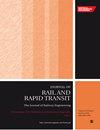钢轨车轮近表面组织演变对微弯曲裂纹萌生的影响
IF 1.7
4区 工程技术
Q3 ENGINEERING, CIVIL
Proceedings of the Institution of Mechanical Engineers Part F-Journal of Rail and Rapid Transit
Pub Date : 2023-07-25
DOI:10.1177/09544097231191550
引用次数: 1
摘要
在使用过程中,严重的机械和热载荷以及腐蚀环境会改变轨道车轮的近表面微观结构。由此产生的严重塑性变形(SPD)和腐蚀影响的显微组织容易影响沿车轮踏面裂纹的萌生。为了评价钢轨车轮的裂纹萌生和断裂行为,本文首次将原位微弯曲法应用于钢轨车轮的现场试样。结果揭示了SPD微结构材料行为的详细见解,其中进行的微弯曲研究指出了弯曲期间微悬臂梁的人工缺口处没有裂纹的主要塑性行为。相比之下,在氧和硅成分增加的微结构区域进行的微弯曲研究显示,裂纹萌生、断裂和较低的最大应力水平(约为SPD微结构的七分之一)。本研究通过一种新的高空间分辨率测试方法,强调了腐蚀影响区域裂纹萌生的风险增加,并认识到在服役的轨道轮定期重新轮廓的重要性。本文章由计算机程序翻译,如有差异,请以英文原文为准。
Influence of the evolution of near-surface rail wheel microstructure on crack initiation by micro-bending investigations
Severe mechanical and thermal loadings, as well as the corrosive environment change the near-surface microstructure of rail wheels during service. Resulting severely plastically deformed (SPD) and corrosion affected microstructures are prone to influence crack initiation along the wheel tread. To evaluate the crack initiation and fracture behaviour, the in-situ micro-bending method is first applied on rail wheel samples from field within this work. Results reveal detailed insights in material behaviour of SPD microstructures, where the conducted micro-bending investigations point out predominant plastic behaviour without cracks initiated at the artificial notch of the micro-cantilevers during bending. In contrast, micro-bending investigations in microstructural regions with increased oxygen and silicon composition show crack initiation, fracture, and low maximum stress levels (approximately one seventh of the SPD microstructure). The presented study underlines the increased risk of crack initiation in corrosion affected regions by a novel testing method in this field with high spatial resolution and acknowledge the importance of periodic reprofiling of the rail wheels in service.
求助全文
通过发布文献求助,成功后即可免费获取论文全文。
去求助
来源期刊

CiteScore
4.80
自引率
10.00%
发文量
91
审稿时长
7 months
期刊介绍:
The Journal of Rail and Rapid Transit is devoted to engineering in its widest interpretation applicable to rail and rapid transit. The Journal aims to promote sharing of technical knowledge, ideas and experience between engineers and researchers working in the railway field.
 求助内容:
求助内容: 应助结果提醒方式:
应助结果提醒方式:


